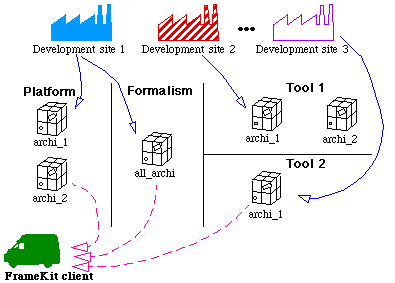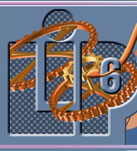Introduction
Our main objective is to enable incremental installation, uninstallation
and upgrade of the FrameKit platform. This procedure must also allow any
FrameKit administrator to perform incremental installation, uninstallation
and upgrade of any tool inside any environment built on top of FrameKit
without having to be "root".
To achieve this goal, the FrameKit installation and uninstallation procedure
is performed by a specific tool : admin_kit.
Kit,
the Instalation Component
Our distribution approach is based on the kit notion. A kit is
an installation component that contains elements. There are three types
of kits:
- Platform kits contain executable and data of the FrameKit platform,
- Formalism kits contain all the required information to insert
a new formalism in an installed FrameKit platform;
- Tool kits contain all the required information to install a
tool (and its associated set of services) in a an installed Framekit
platform for an installed formalism.
Kits are nammed and are associated to a target architecture (hardware
+ OS). Platform kits are associated with a target architecture but not
with a formalism. Formalisms may not be associated to a target architecture
(if there is not related executable file for verification). Tool kits
are associated with both a target architecture and a formalism.
Installation
Strategy
Figure 1 presents an example of this strategy. Let us imagine a
web site in which there are:
- two platform kits (for architecture archi_1 and archi_2) and a formalism
kit (not related to any architecture) coming from development site 1;
- tool kits for tool 1 asociated to the available formalism and available
for architectures archi_1 and archi_2 coming from development site 2;
- tool kit for tool 2, only available for architecture archi_1 coming
from development site 3.

Figure 1: Development and distribution strategy of FrameKit.
Let us imagine a client who wants to install a FrameKit based environment
about this available formalism for archi_1. He only has to instll the
required tools for the required architecture. If, later on, he buy archi_2
hardwarde, he may upgrade his environment with kits for this new architecture.
Upgrade of tools, formalisms and platform may be performed as well: the
new kit is the only item to import and install.
So, this procedure allows an "à la carte" installation by any
user. It also allow a distributed kit development all over Internet.
Packages
To ease the life of somebody who wants to download a full and coherent
configuration without having to get kits one by one. It is possible to
get packages. A package is a tar file that contains a predefined
set of packages. You download it, you untar it and apply the installation
procedure as explained in the READ_ME file you get in it.
Click here to get more information
about packages.
|









